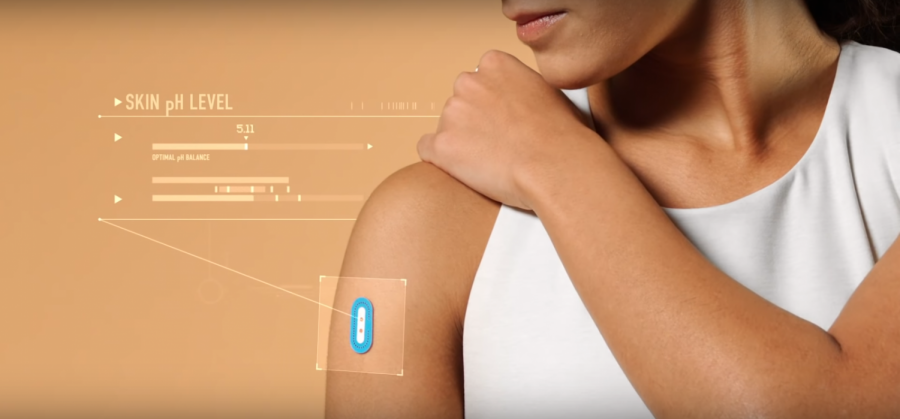Northwestern researchers’ pH-tracking skin patch wins CES innovation award
A skin pH measuring device developed by Northwestern researchers and L’Oréal. The device won an innovation award at this year’s CES convention in Las Vegas.
January 14, 2019
A new device that measures skin acidity developed by cosmetics company L’Oréal and McCormick Prof. John Rogers won an innovation award in wearable technology at a technology conference in Las Vegas.
The flexible, waterproof patch, called My Skin Track pH, is designed to gather sweat without requiring physical exertion, collecting small amounts during showers and baths to determine pH levels. Users can determine if they have healthy skin by seeing if the pH is between 4.5 and 5.5 — the healthy range, according to L’Oréal’s dermatologists, said Guive Balooch, the global vice president of L’Oréal’s technology incubator.
The device allows people to easily determine their skin’s health, said Balooch. Although researchers have known about the relation between pH and skin health for several decades, the device allows people to conduct their own litmus tests without much effort, he said.
My Skin Track pH debuted at this year’s CES, a consumer electronics convention where over 4,500 companies debut technology to about 180,000 attendees. The device, which is not yet commercially available, won a best in innovation award in wearable technologies, competing against 28 other honorees including devices from Fitbit and LG Electronics.
“We’re trying to unlock measurements that’ve never been done before,” Balooch said. “We’re very honored to win an award in a field that’s not beauty.”
When Rogers and his team published a study about a groundbreaking sweat patch that detected chemical levels in Nov. 2016, L’Oréal approached him about tailoring the device to their needs. Rogers said he’s worked with L’Oréal over the years, so they’d already developed a “great synergy.”
“It’s really unique to have someone so academically world-leading care so much about innovating in science and also making commercial products that can be worked on with L’Oréal,” Balooch said. “I cherish those aspects, and that’s why our partnership has been so fruitful.”
My Skin Track pH is unlike the sweat patch Rogers developed with Gatorade, which was recently featured in the company’s most-viewed ad on YouTube with Serena Williams. Gatorade’s patch mostly tracks sweat and electrolyte loss, and it’s larger than L’Oréal’s device because it needs to accommodate more sweat, Rogers said.
When people use My Skin Track pH, they begin to see colored dots as sweat seeps into the device, Rogers said. The dots function as a timer for the process, said McCormick research Prof. Roozbeh Ghaffari. When all dots are colored, users know the pH analysis is ready.
Ghaffari, the CEO of a startup he and Rogers co-founded to work on commercial products, said even though the pH device is a prototype, he and Rogers plan to continue working on microfluidics technology and hope to create pragmatic commercial products.
“This tech around wearable microfluidics has a lot of really cool applications that we’re just starting to see come to light,” Ghaffari said. “It’s really exciting to see the technology come about in a real way.”
Email: [email protected]
Twitter: @dvesurai
Related Stories: Serena Williams sports sweat patch designed by Northwestern researchers in a Gatorade ad


